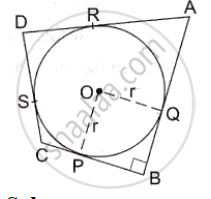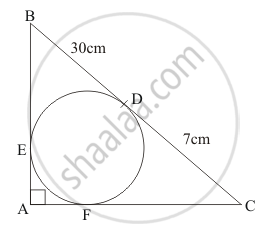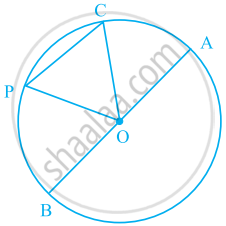Advertisements
Advertisements
प्रश्न
In the given figure, a circle with center O, is inscribed in a quadrilateral ABCD such that it touches the side BC, AB, AD and CD at points P, Q, R and S respectively. If AB = 29cm, AD = 23cm, ∠B = 90° and DS=5cm then find the radius of the circle.

उत्तर
We know that tangent segments to a circle from the same external point are congruent
Now, we have
DS = DR, AR = AQ
Now AD = 23 cm
⇒ AR + RD = 23
⇒ AR =23- RD
⇒ AR = 23 -5 [ ∴ DS = DR = 5]
⇒ AR = 18 CM
Again , AB= 29 cm
⇒ AQ +QB = 29
⇒ QB = 29-AQ
⇒ QB = 29-18 [∵ AR = AQ = 18]
⇒QB = 11CM
Since all the angles are in a quadrilateral BQOP are right angles and OP = BQ
Hence, BQOP is a square.
We know that all the sides of square are equal.
Therefore, BQ = PO = 11 cm
APPEARS IN
संबंधित प्रश्न
Points A(–1, y) and B(5, 7) lie on a circle with centre O(2, –3y). Find the values of y. Hence find the radius of the circle.
In fig., O is the centre of the circle, PA and PB are tangent segments. Show that the quadrilateral AOBP is cyclic.
If AB, AC, PQ are tangents in Fig. and AB = 5cm find the perimeter of ΔAPQ.
Two tangent segments PA and PB are drawn to a circle with center O such that ∠APB =120°. Prove that OP = 2AP
Fill in the blank:
An arc is a ................ when its ends are the ends of a diameter.
Draw different pairs of circles. How many points does each pair have in common? What is the maximum number of common points?
In the given figure, BDC is a tangent to the given circle at point D such that BD = 30 cm and CD = 7 cm. The other tangents BE and CF are drawn respectively from B and C to the circle and meet when produced at A making BAC a right angle triangle. Calculate (i) AF

If \[d_1 , d_2 ( d_2 > d_1 )\] be the diameters of two concentric circle s and c be the length of a chord of a circle which is tangent to the other circle , prove that\[{d_2}^2 = c^2 + {d_1}^2\].
If an isosceles triangle ABC, in which AB = AC = 6 cm, is inscribed in a circle of radius 9 cm, find the area of the triangle.
In the given figure, O is the centre of the circle. Shade the smaller segment of the circle formed by CP.
